
Now the World Cup dust has settled and we know ‘it’ eventually went chez to France, post tournament analysis begins in earnest, looking back to plan ahead for the next major event.
For England men’s team, that will be the 2020 European Championship. For the English Football Association, attention will turn to the Women’s World Cup next summer, assuming, as appears very likely, qualification is secured.
Both tournaments will present The FA’s media and communications team with grand stages to build on the success of Russia where its digital content and social media strategy was hailed as an influential factor in reconnecting despondent England fans with the national team.
Whilst Gareth Southgate’s players exceeded expectations to reach the semi-finals before running out of steam against a wily Croatia side in Moscow, The FA utilised its digital channels superbly to drive, reflect and amplify the feel-good factor of a revitalised nation of Three Lions supporters.
With bespoke content produced for The FA’s main social media channels including twitter, Facebook, YouTube and Instagram, many bases were covered to engage fans in the digital space.
And it wasn’t just the The FA who registered impressive digital and social content results. World football’s governing body FIFA hailed Russia 2018 as the most engaged World Cup in history. Headline figures from FIFA’s post-tournament analysis include:
- Over 7.5 billion engagements across all FIFA digital platforms
- 25 billion video views during the FIFA World Cup
- Over 580 million interactions on FIFA social media platforms during tournament
As with The FA, FIFA enhanced audience engagement through a range of new digital innovations and initiatives including a new app, broader and more interactive coverage on social media, and a new visual stories approach to content.
Much of this was recognised by my own research undertaken throughout the 32-day tournament whereby @england and @fifaworldcup were two of eight accounts monitored each day on Instagram Stories to locate and analyse various approaches to digital storytelling.
From governing bodies to sports brands through to players, the intention was to gauge how Instagram Stories in particular was being used to tell the tournament’s story from various perspectives.
The full findings, methodology and theoretical analysis are intended to be presented in a journal article/paper. For now, what follows is an abridged version of my approach with some key findings.
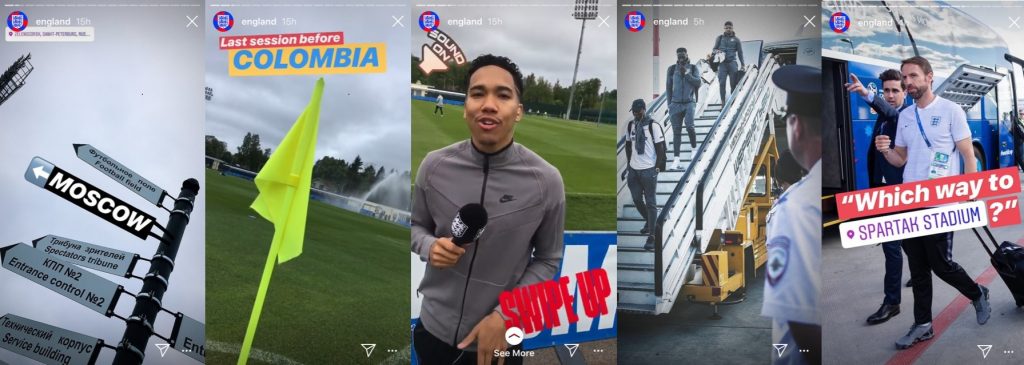
Held to Account
The Instagram accounts monitored for 34 days from the day prior to the World Cup opening ceremony and first match between hosts Russia and Saudi Arabia, to the day after the final between France and Croatia were as follows:
@england; @fifaworldcup; @socceroos (Australia national team); @nikefootball; @adidasfootball; @mosalah; @neymarjr; @harrykane
From the positivity generated by Southgate’s youthful England side complemented neatly by The FA’s creative approach to social media, to Nike’s team and player-focused narratives to help market and sell kit and merchandise, the clamour for audience engagement in the digital space was at times as competitive as events on the pitch.
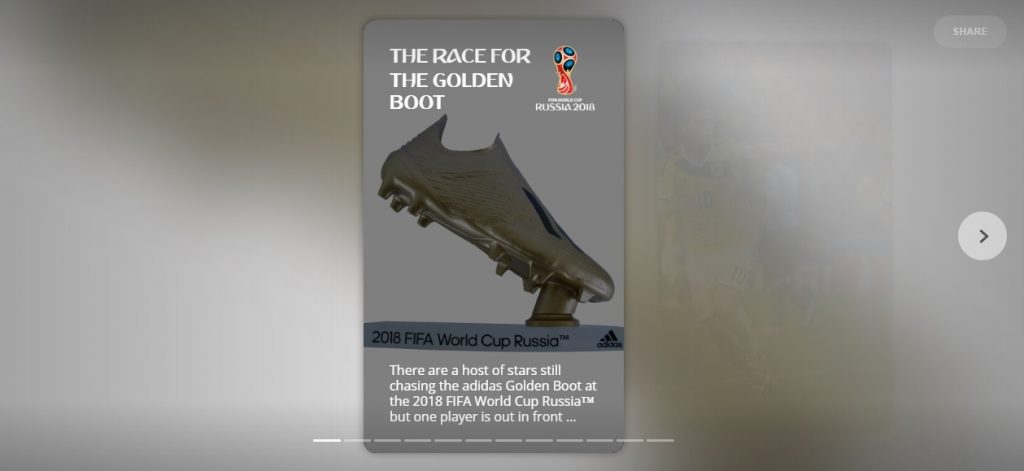
Drawing on Handler Miller’s work (2014) that proposes how innovations in digital media lead to corresponding developments in storytelling, the adoption and growth of Instagram Stories by sports and, in this case, football-specific ‘agencies’ made the platform a good fit with this being the first World Cup since the launch of Insta Stories in August 2016.
Whilst previous studies have addressed social media’s role within football, most notably via Facebook and Twitter, (see among others: social media as a communication tool – Hambrick et al 2010; social media as a fan engagement tool – Allison 2014; issues with online sports brand promotion – McArthy et al 2014; social media and marketing strategy – Parganas and Anagnostopoulos 2015) none appear to have focused on Instagram Stories specifically.
Anagnostopoulos et al’s 2017 study Branding in Pictures is concerned with how professional team sport organisations use Instagram for branding purposes with an emphasis on the meaning of followers’ reactions to the organisations’ Instagram activity.
Reichart Smith and Sanderson’s 2015 study I’m going to Instagram it! also deals with the platform but not the Stories facility (it wasn’t yet in the public domain) and rather focuses on how athletes are using Instagram for self-representation.
As much of the above can be brought into play here, my research can hopefully extend the literature by focusing on how Instagram Stories was used during the World Cup 2018 for digital storytelling to explore what narratives were being created, who by, why and how ie: what is the intention of the narrative and what forms and techniques are used to produce content. It is with the latter areas of form and technique where the research also explores the role of mobile/smartphone content production and consumption in the digital storytelling process.

Rolling with Neymar
As the group stage of the World Cup unfolded, it soon became apparent that the more creative narratives would be delivered via brand managed accounts as against individual player accounts, although we know the latter will at times be controlled by account managers, particularly in elite sports.
It was no surprise the most active of the three player accounts monitored was @neymarjr. Brazil’s star man added to his story almost daily throughout the tournament before going to ground for a week following the Selecao’s quarter-final exit. If a week is a long time in politics, a week off social media is an eternity for Neymar.
As with @harrykane and the much less active @mosalah, player content was somewhat basic from training or match stills with emojis and handle links to several boomerangs posted by @neymarjr.
Of note was the occasional cross-posting of branded content from @nikefootball (Kane and Neymar) and @adidasfootball (Salah) to take advantage of their client’s sizeable follower base. These activations would generally take the form of a short video narrative composed around the player’s key attributes utilising the ‘swipe up’ call-to-action (CTA) to related social platforms such as Adidas Football’s YouTube or to satellite sites like Nike Bootroom where promoted kit and other sportswear can be purchased.
Examples of activations integrating storytelling across social platforms:
- Kevin De Bryune – Listen To Yourself
- Leaving Madeira featuring Ronaldo and Ronaldont
- Paint The Streets – The Gabriel Jesus Mural
Whilst much of this content adopted shorter form delivery with mobile device consumption in mind, there were some notable longer form exceptions. Nike Football’s 18 minute documentary This is Naija: The Story of Nigerian Football was a standout example of longer form storytelling.
https://www.youtube.com/watch?v=ixMZZicONDs&t=23s
Likewise, @england also created narratives on Instagram Stories with the intention to drive traffic to other digital platforms. This was mostly apparent with @england’s innovative Lions’ Den show hosted on YouTube. Short teaser videos with featured England players and/or lives to camera with presenter Craig Mitch would be dropped into an Instagram Story with a CTA for audience to engage with longer form Lions’ Den content on YouTube.
In addition, @england took the initiative to invite fans behind the scenes with exclusive live streams and clipped footage from training sessions interspersed with screen grabs from other social media platforms, mainly Instagram and twitter, to reflect messages from current and former players in the build-up to and reaction around games.
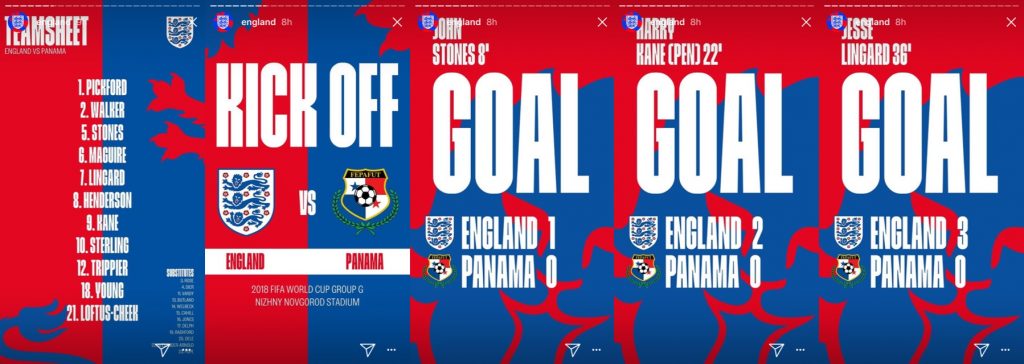
During matches @england devised a set format to complement the more traditional, linear match reporting methods with a graphic-led narrative on Instagram Stories to update on line-ups, goals, half-time and full-time scores. This visual narrative conformed to a house style delivered across twitter and Facebook to provide an integrated approach to storytelling during matches. Crucially here, content was tailored for mobile device consumption.
The @socceroos account also often used narratives created on Instagram Stories to link out to content on the official website, albeit this tended to be more traditional coverage such as press conference write ups, player interviews and text based features and news stories. Like @england, much of the @socceroos behind-the-scenes content was captured on mobile devices for ease of access and distribution.
https://www.youtube.com/watch?v=Iw1jF32klNk&t=12s
Pay Like Zlatan
A balance between commercial interests and tournament/match promotion was struck by @fifaworldcup from the outset. Obligated to promote official World Cup commercial partners @fifaworldcup went all out on Day 1 with a conceptual narrative featuring former Sweden and Manchester United star Zlatan Ibrahimovic and Visa. Throughout the opening match between hosts Russia and Saudi Arabia, selfies of Ibrahimovic proudly sporting Visa branded clothing in the stand (VIP area no doubt) were added to the story with typically Zlatan-style comments in response to action on the pitch, such as: ‘Nice goal. But I would have hit it earlier, like from the halfway line.’ Each section would include a handle link to Visa with the hashtag #PayLikeZlatan.
Some FIFA paid partnerships were delivered through experimentation with gamification such as the Wanda sponsored World Cup Bracket Challenge and Hyundai presented World Cup Match Predictor. These would link from Instagram Stories to bespoke sponsored landing sections on FIFA’s official website to encourage fan interaction while providing focused exposure for the paying commercial partner.
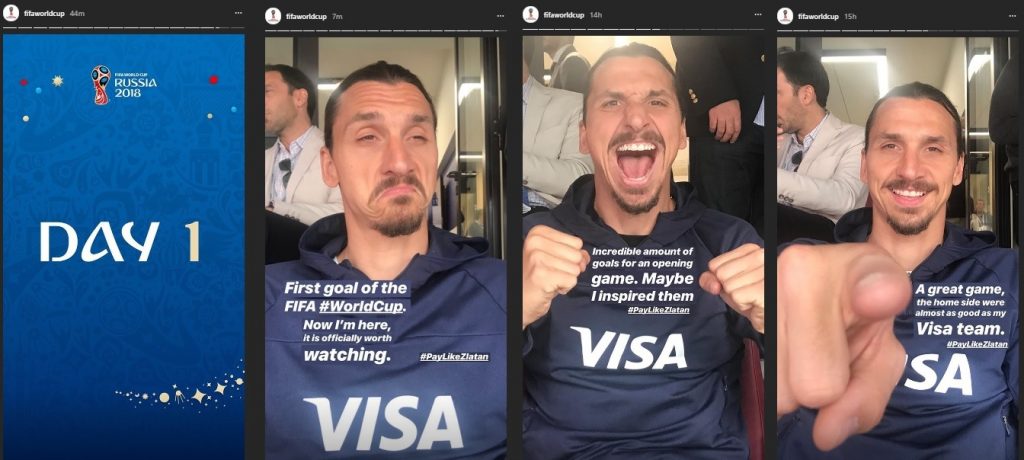
With this, @fifaworldcup also devised two consistent narratives for each matchday throughout the World Cup. The first ran through the group stages. The second was introduced at the knockout stage. Both narratives, while different in terms of style and structure, included a combination of ‘professional’ footage and mobile footage, the latter spontaneous footage often involving fans outside stadia in the build up to or aftermath of a game. One aspect of this narrative was the hashtag #RivalHug that brought together fans from opposing teams to, well, hug. The match narrative itself would take the form of stills with linked player handles and, of course, always a sponsored link to the @budweiser man-of-the-match.
Perhaps FIFA’s most telling innovation was its Visual Stories offering, a concept created very much with mobile device consumption in mind. By picking up on angles generated through the tournament, Visual Stories would develop timely narratives to provide context and depth to stories. Hosted on FIFA’s official website, content was created in sections or chapters with a touch scroll functionality that seemingly lends directly from the Instagram Stories interface, replicating UX that works best on mobile devices.
Sample of FIFA Visual Stories:
- The Race For The Golden Boot
- Mbappe’s Big Day
- Igor Akinfeev – Russia’s New Hero
- Round Of 16: Did You Know?
- Modric: Captain Croatia
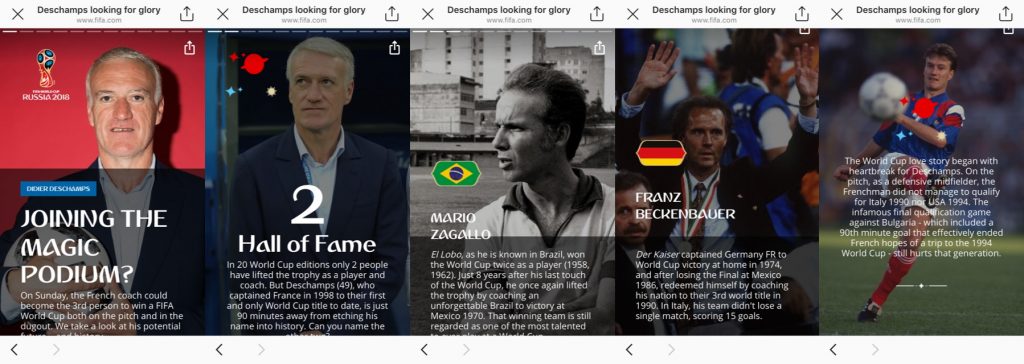
There are multiple conclusions to draw from observing the use of Instagram Stories throughout the 2018 World Cup, many of which, as previously mentioned, I intend to pull together in a longer, more formal article.
But from my reading thus far there is one particular proposition from McArthy et al (2014, p181) that stands out in that “further development of social media strategies had potential to deliver interaction and engagement, community growth and belonging, traffic flow to official websites and commercial gain…”
I would suggest from my observations throughout the 2018 World Cup, the potential McArthy et al highlighted four years ago is now very much being realised with digital storytelling playing an influential role. Increasingly sports brands, governing bodies and players as brands in their own right, are using social technologies such as Instagram Stories to creative digital narratives to interact with and engage audience. In line with increased content consumption via handheld devices, these narratives are starting to be created with the mobile audience very much in mind.